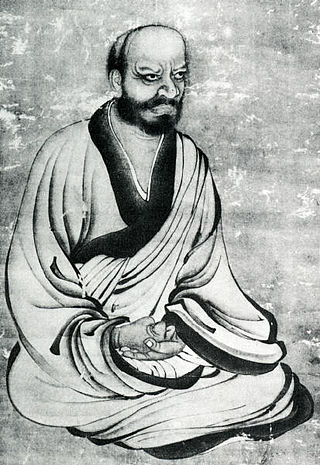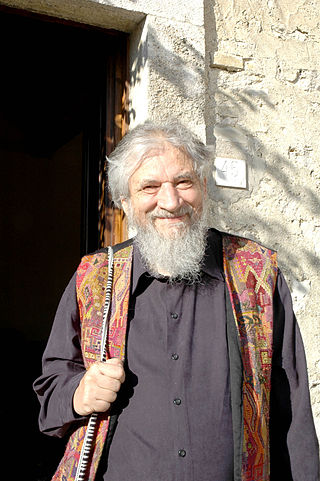
Carl Ransom Rogers was an American psychologist who was one of the founders of humanistic psychology and was known especially for his person-centered psychotherapy. Rogers is widely considered one of the founding fathers of psychotherapy research and was honored for his pioneering research with the Award for Distinguished Scientific Contributions by the American Psychological Association (APA) in 1956.

Linji Yixuan was the founder of the Linji school of Chán Buddhism during Tang dynasty China.

Chögyam Trungpa was a Tibetan Buddhist meditation master and holder of both the Kagyu and Nyingma lineages of Tibetan Buddhism.

Claudio Benjamín Naranjo Cohen was a Chilean psychiatrist who is considered a pioneer in integrating psychotherapy and the spiritual traditions. He was one of the three successors named by Fritz Perls, a student of Oscar Ichazo who originally developed the Enneagram of Personality, and a founder of the Seekers After Truth Institute. He was also an elder statesman of the US and global human potential movement and the spiritual renaissance of the late 20th century. Naranjo authored several books.
Reginald Ray is an American Buddhist academic and teacher.

The Sutra of Perfect Enlightenment or Complete Enlightenment is a Mahāyāna Buddhist sūtra highly esteemed by both the Huayan and Zen schools. The earliest records are in Chinese, and it is believed to be of Chinese origin.

Self-Realization Fellowship (SRF) is a worldwide religious organization founded in 1920 by Paramahansa Yogananda, the Indian guru who authored Autobiography of a Yogi. Before coming to the United States, Yogananda began his spiritual work in India in 1917 and named it Yogoda Satsanga Society of India (YSS). He came to the West in 1920 and in 1925 established SRF's headquarters at Mount Washington, Los Angeles, California. Before his return visit to India in 1935, he legally incorporated SRF in the United States, designating it as the only organization to carry on his work – to care for and disseminate his teachings.
In Mahayana Buddhism, bodhicitta,, is the mind (citta) that is aimed at awakening (bodhi), with wisdom and compassion for the benefit of all sentient beings. Bodhicitta is the defining quality of the Mahayana bodhisattva and the act of giving rise to bodhicitta (bodhicittotpāda) is what makes a bodhisattva a bodhisattva. The Daśabhūmika Sūtra explains that the arising of bodhicitta is the first step in the bodhisattva's career.

Geshe Kelsang Gyatso was a Buddhist monk, meditation teacher, scholar, and author. He was the founder and spiritual director of the New Kadampa Tradition-International Kadampa Buddhist Union (NKT-IKBU), a registered non-profit, modern Buddhist organization that came out of the Gelugpa school/lineage. They have 1,300 centres around the world, including temples, city temples and retreat centres that offer an accessible approach to ancient wisdom.

Sheng Yen, born Zhang Baokang, was a Taiwanese Buddhist monk, religious scholar, and writer. He was one of the mainstream teachers of Chan Buddhism. He was a 57th generational dharma heir of Linji Yixuan in the Linji school and a third-generation dharma heir of Hsu Yun. In the Caodong lineage, Sheng Yen was a 52nd-generation Dharma heir of Dongshan Liangjie (807-869), and a direct Dharma heir of Dongchu (1908–1977).

Andrew Cohen is an American spiritual teacher. He is an author, former editor of What Is Enlightenment? magazine, and founder of the global spiritual community EnlightenNext, which dissolved in 2013.
The Vipassanā movement, also called the Insight Meditation Movement and American Vipassana movement, refers to a branch of modern Burmese Theravāda Buddhism that promotes "bare insight" (sukha-Vipassana) to attain stream entry and preserve the Buddhist teachings, which gained widespread popularity since the 1950s, and to its western derivatives which have been popularised since the 1970s, giving rise to the more dhyana-oriented mindfulness movement.

Dhammakaya meditation is a method of Buddhist Meditation developed and taught by the Thai meditation teacher Luang Pu Sodh Candasaro (1885–1959). In Thailand, it is known as Vijjā dhammakāya, which translates as 'knowledge of the dhamma-body'. The Dhammakaya Meditation method is popular in Thailand and other parts of Southeast Asia, and has been described as a revival of samatha (tranquility) meditation in Thailand.

Nan Huai-Chin was a Chinese Buddhist monk, religious scholar, and writer. A well-respected spiritual teacher in contemporary China, he was considered by many to be the major force in the revival of Chinese Buddhism. While Nan was regarded by many in China as one of the most influential Chan Buddhist teachers and Vajrayana teachers, particularly in the Cundī practices, he was little known outside the Chinese cultural sphere. Nan died at the age of 94 on Sept. 29th, 2012 in Suzhou, China.
Seongcheol was a Korean Seon master. He was a key figure in modern Korean Buddhism, being responsible for significant changes to it from the 1950s to 1990s.

Commonly referred to as Luangpor Thong, Luangpor Thong Abhakaro is a Buddhist monk and teacher of Mahasati Meditation, a meditation method developed by his teacher, Luangpor Teean Jittasubho. The title Luangpor is used in Thailand to express respect for senior Buddhist monks and it means 'venerable father'.

Kripalvananda, also known as Swami Sri Kripalvanand or Bapuji, was a renowned master of kundalini yoga and the namesake of the Kripalu Center, Kripalu Yoga style and Kripalvananda Yoga Institute, as well as a significant influence on Kriya Yoga in the United States.
Zen is a school of Mahayana Buddhism that originated in China during the Tang dynasty as the Chan School or the Buddha-mind school ," and later developed into various sub-schools and branches. From China, Chán spread south to Vietnam and became Vietnamese Thiền, northeast to Korea to become Seon Buddhism, and east to Japan, becoming Japanese Zen.
Tergar Meditation Community is a Buddhist meditation community led by Tibetan meditation master and writer Yongey Mingyur Rinpoche.
Anne Cushman is an American teacher of yoga as exercise and meditation, a writer on Mindful Yoga, and a novelist. Her novel Enlightenment for Idiots was named by Booklist as one of the top ten novels of 2008. Cushman has also been an editor for Yoga Journal and Tricycle: The Buddhist Review. She directs mentoring programs and multi-year meditation training for yoga teachers at the Spirit Rock Meditation Center, emphasizing the fusion of yoga and Buddhist meditation and highlighting their shared history and philosophy.












